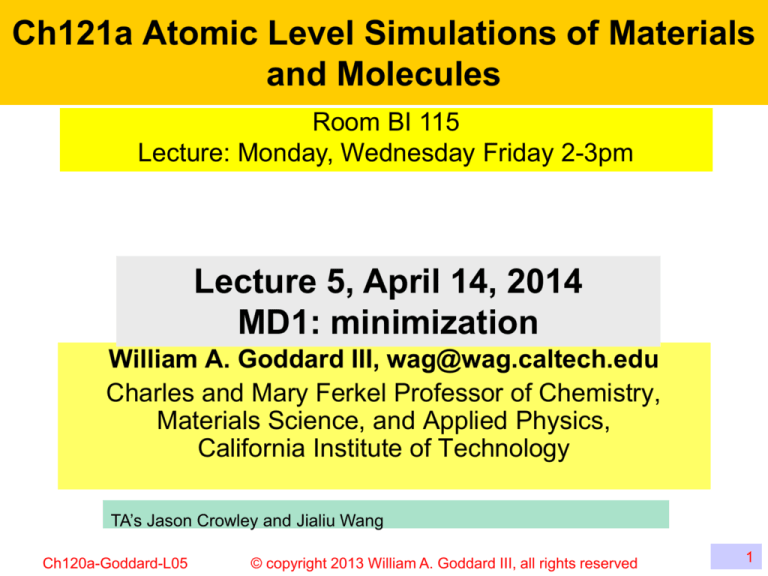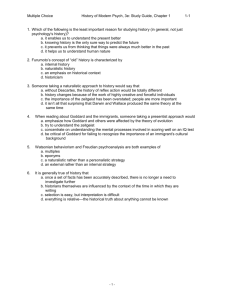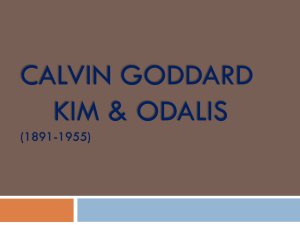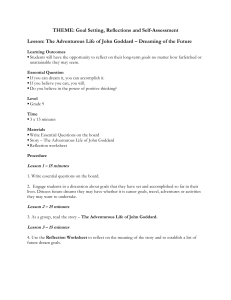
Ch121a Atomic Level Simulations of Materials
and Molecules
Room BI 115
Lecture: Monday, Wednesday Friday 2-3pm
Lecture 5, April 14, 2014
MD1: minimization
William A. Goddard III, wag@wag.caltech.edu
Charles and Mary Ferkel Professor of Chemistry,
Materials Science, and Applied Physics,
California Institute of Technology
TA’s Jason Crowley and Jialiu Wang
Ch120a-Goddard-L05
© copyright 2013 William A. Goddard III, all rights reserved
1
Homework and Research Project
First 5 weeks: The homework each week uses generally available
computer software implementing the basic methods on
applications aimed at exposing the students to understanding how
to use atomistic simulations to solve problems.
Each calculation requires making decisions on the specific
approaches and parameters relevant and how to analyze the
results.
Midterm: each student submits proposal for a project using the
methods of Ch121a to solve a research problem that can be
completed in the final 5 weeks.
The homework for the last 5 weeks is to turn in a one page report
on progress with the project
The final is a research report describing the calculations and
conclusions
Ch120a-Goddard-L05
© copyright 2013 William A. Goddard III, all rights reserved
2
Now that we have a FF, what do we do with it?
Calculate the optimum geometry
Calculate the vibrational spectra
Do molecular dynamics simulations
Calculate free energies, entropies, phase diagrams
…..
Ch120a-Goddard-L05
© copyright 2013 William A. Goddard III, all rights reserved
3
Energy minimization Newton’s Method – 1D
Expanding the energy expression about x0, we can write
E(d) = E0 + d E0’ + ½ d2 E0” + O(d3)
Where E’= (dE/dx)x0 and E” = (d2E/dx2)x0 at x0.
E
At an energy minimum we have
x0
E’(dmin) = E0’ + dmin E0” = 0
and hence dmin =– E0’/E0”
xmin
Thus give E0’ and E0” at point x0 we
can estimate the minimum.
If E(x) is parabolic this will be the exact
x
Minimum.
This is called Newton’s method
Of course, E(x) may not be exactly parabolic.
But then we recalculate E1’ and E1” at point 1 and estimate the
minimum to be at x2 = x1 – E1’/E1”,
This process converges quadratically. That is the error at each
iteration
is the square©of
the 2013
previous
Ch120a-Goddard-L05
copyright
William A. error.
Goddard III, all rights reserved
4
More on Newton’s Method – 1D
Newton’s method will rapidly
locate the nearest local minimum
if E” > 0.
Note in the illustration, that this
may not be the global minimum,
which is at x2min.
Also, if E” < 0 (eg. Between the
green lines) Newton’s method
takes us to a maximum rather
than a minimum
Ch120a-Goddard-L05
E
x0
xmin
© copyright 2013 William A. Goddard III, all rights reserved
x2min
x
5
Energy minimization – 1D – no E”
Now consider that we only know the slope, not the 2nd derivative.
We start at point x0 of a one dimensional system, E(x), and want
to find the minimum, xmin=x0 + dx
E
Given the slope, E’=(dE/dx)x0 we know
x0
which way to go, but not how far.
x1
Clearly we want dx = - lE’
xmin
That is we move in the direction
opposite the slope, E’, but how far?
With just E’, we cannot know. Thus
x
we could pick some initial value l1
and evaluate the energy E1 and slope E1’ at the new point.
If the new E1’ has the opposite slope, then we have bounded the
minimum, and we can fit a parabola to estimate the minimum
xmin = x0 – E0’/k where
k= (E1’ – E0’)/(x1-x0) is the curvature of this parabola.
Ch120a-Goddard-L05
© copyright 2013 William A. Goddard III, all rights reserved
6
Energy minimization – one dimensional
We would then evaluate E(xmin) to make sure that both points
were in the same valley (and not x2).
In the case that the 2nd point was x3,
E
no change in slope, then we want to
x0
jump farther until E’ changes sign so
that the minimum is bounded.
xmin
x3
In the case that the 2nd point was x2,
x2
then the new energy would not
match the prediction based on the
x
parabola.
In this case we would choose whichever point of x0, xmin, and x2
had the lowest energy and we would use the E’ to choose the
direction, but we would choose the jump, l, to be much smaller,
say a factor of 2 than before (some people like using the Golden
Mean of 2/[sqrt(5)-1] = 1.6180)
Ch120a-Goddard-L05
© copyright 2013 William A. Goddard III, all rights reserved
7
Energy minimization - multidimensional
Consider a molecule with N atoms (J=1,N),
It has 3N degrees of freedom (Ja, 1x to Nz) where a =x,y,z
Denote these 3N coordinates as a vector, R.
The energy is then E(R)
Starting with an initial geometry, R0, consider the new geometry,
Rnew = R0 + dR, and expand in a Taylor series
E(Rnew)=E(R0)+Sk(dR)k(∂E/∂Rk)+½Sk,m(dR)k(dR)m(∂2E/∂Rk∂Rm)
+O(d3)
Writing the the energy gradient as E = (∂E/∂Rk) and
the Hessian tensor as H=2E = (∂2E/∂Rk∂Rm)
This becomes
E(Rnew)=E(R0)+ (dR)∙E + ½ (dR)∙H∙(dR) + O(d3)
Ch120a-Goddard-L05
© copyright 2013 William A. Goddard III, all rights reserved
8
Newton Raphson method in 3N space
Given E(Rnew)=E(R0)+ (dR)∙E + ½ (dR)∙H∙(dR)
The condition that Rnew = R0 + dR lead to a minimum is that
E + H∙(dR) = 0
Bearing in mind that H is a matrix, the solution is
(dR) = - (H)-1∙ E where (H)-1 is the inverse of H
This is exactly analogous to Newton’s method in 1D
dmin =– E0’/E0”
and in multidimensions it is called Newton-Raphson (NR) method.
There are a number of practical issues with NR. First for Hb, with
6000 atoms the Hessian matrix would be of dimensions 18000 by
18000 and hence quite tedious to solve or even to store.
First we must be sure that all eigenvalues of the Hessian are
nonzero, since otherwise the inverse will be infinite.
Such zero eigenvalues might seem implausible. But for a finite
molecule with 3 or more atoms there are always 6 zero modes.
Ch120a-Goddard-L05
© copyright 2013 William A. Goddard III, all rights reserved
9
Hessian problems
For example, translating all atoms of finite molecule by a finite
distance in the x, y, or z directions cannot change the energy.
In addition rotating a nonlinear molecule about either the x, y, or
z axis cannot change the energy.
Thus we must remove these 6 dof from the Hessian, reducing it
to a (3N-6) by (3N-6) matrix before inverting it
For a linear molecule, there are only 2 rotational modes, but if
there are more than 2 atoms (say CO2) the dynamics will almost
always lead to nonlinear structures, so we must consider 3N-6
dof. However for diatomics, there is only one nonzero
eigenvalue (Bond stretch)
Also all (3N-6) eigenvalues of the Hessian must be positive,
otherwise NR will lead to a stationary point that is a maximum
forCh120a-Goddard-L05
some directions. © copyright 2013 William A. Goddard III, all rights reserved
10
Steepest descents – 1st point
Generally it is impractical to evaluate and diagonalize the
Hessian matrix, thus we must make do with just, E, the
gradient in 3N dimensions (no need to separate out
translation or rotation since there will be no forces for these
combinations of coordinates).
Obviously, it would be best to move along the direction with
the largest negative slope, this is called the steepest
descent direction, u = -E/|E|, where u is a unit vector
parallel with the vector E but pointed downhill.
Then dR = l u, where l is a scalar
Just as in 1D, we do not know how far to move, so we pick
some value, l, and evaluate E1 at the new point.
Of course E1 will generally have a component along u,
(u∙E1) plus a component perpendicular to u.
Here we proceed just as in the 1D case to bound the
minimum
and predict
the minimum
the path
Ch120a-Goddard-L05
© copyright
2013 William A.energy
Goddard III, along
all rights reserved
11
Steepest descents – more on 1st point
Regarding the first l, Newton’s method suggests that it be
l = 1/k where k is an average force constant (curvature in the
E direction). In biograf/polygraf/ceriusII I used a value of
k=200 as a generally good guess.
Also note from the discussion of the 1D case, we want the first
point to overshoot the minimum a bit so that the slope is
positive. This way we can calculate k from the two slopes and
predict a refined minimum.
At the predicted minimum, we evaluate the slope in the original
steepest descent direction and if it is small enough
(significantly smaller than the other 2 slopes) and if the new
energy is lower than the original energy, we use the new point
to predict a new search direction
Ch120a-Goddard-L05
© copyright 2013 William A. Goddard III, all rights reserved
12
Steepest descents – 2nd point
Starting from our original point x0 with slope E0, we moved
in the direction, u0 = -E0/|E0| to find a final new position
R1, along unit vector u0.
Now we calculate E1 and a unit vector u1 = -E1/|E1|.
If R1 was an exact minimum along unit vector u0 then u1 will
be orthogonal to u0.
In the Steepest Descents (SD) method, we continue as for
the 1st point to find the minimum R2 along unit vector u1, and
then the minimum R3 along unit vector u2.
The sequence of steps for
SD is illustrated at the right.
Here we see that the
u0 u1 u0
u1
process of minimizing along
u1, can result in no longer
having a minimum along u0
Ch120a-Goddard-L05
© copyright 2013 William A. Goddard III, all rights reserved
13
Conjugate Gradients
Even for a system like Hb with 18000 dof, the beharior shown in
the SD figure is typcial, the system first minimizes along u0 then
along u1, then back along u0 then back along u1, ignoring most of
the other 18000 dof until the minimum in this 2D space is reached,
at which point SD starts sampling other dof.
The Conjugate Gradient method (Fletcher-Reeves) dramatically
improves this process with little extra work.
Here we define v1 = u1 – g u0 where g = (E1∙E1)/ (E0∙E0)
(note the use of the dot or scalar product of the gradient vectors)
Thus the new path v1 combines both directions so that as we
optimize along u1 we simultaneously keep the optimum along u0.
(The ratio g is derived assuming that the energy surface is 2nd
order.) This process is continued, with
v2 = u2 – g u1 where g = (E2∙E2)/ (E1∙E1)
14
TheCh120a-Goddard-L05
new E2 is perpendicular
toWilliam
all previous
© copyright 2013
A. Goddard III, E
all rights
k. reserved
Conjugate Gradients
In 2D, for a system in which the energy
changes quadratically, CG leads to the exact
minimum in 2 steps, whereas SD would take
many steps.
x1
First large systems, CG is the method of
choice, unless the starting structure is really
bad, in which case one might to SD for a few
steps before starting CG. There reason is that
CG is based on assuming that the energy
surface is quadratic so that the point is already in a valley and
we want to find the optimum in that valley.
SD is most appropriate when we start high up in the Alps and
want to jump around to find a good valley, after which we can
convert over to CG.
Ch120a-Goddard-L05
© copyright 2013 William A. Goddard III, all rights reserved
15
Fine points on CG
To ensure convergence, one must never choose a final point
along a path higher than the original point defining the path.
If the final point is higher than the original point then it necessary
to take the two lowest energy points and predict a third along the
same path that is lower.
One must be careful if the first step does not find a change in sign
of the slope along that path. One should predict the new
minimum but if the predicted step is much larger (more thnan 10
times) than the original step, one should jump more cautiously.
With CG the fewest number of points along a pathway would be
1, so that the predict point is close enough to the minimum that a
second checking point is not needed.
R. Fletcher and C.M. Reeves, Function minimization by congugate gradients, Computer
Journal 7 (1964), 149-154
Polak, B. and Ribiere, G. Note surla convergence des methode des directions conjuguees.
16
Ch120a-Goddard-L05
© copyright
2013 (1969)
William A. Goddard III, all rights reserved
Rev. Fr. Imform. Rech. Oper.,
16, 35–43.
Inverse Hessian or Quasi-Newton methods
In Newton-Raphson we choose the new point from
(dR) = - (H)-1∙ E where (H)-1 is the inverse of the Hessian H.
For a system for which the energy is harmonic, this takes us
directly to the minimum in one step
Generally, it is too expensive to actually calculate and save the
Hessian. However each time we search a path, say in CG, to
find the minimum we derive an average force constant in that
direction,
k= (E1’ – E0’)/(x1-x0)
where the gradients are projected along the path.
Thus we can construct an approximate inverse Hessian which
we assume initially to be the unit matrix (SG) but each time we
minimize along a direction we use 1/k along this direction to
improve our approximation to (H)-1.
Ch120a-Goddard-L05
© copyright 2013 William A. Goddard III, all rights reserved
17
Updating the Inverse Hessian
The inverse Hessian, H is built up iteratively, AVOIDing
explicitly inverting the Hessian matrix
lim H k = Hk1
k
rk1 = rk H kE(rk
Hk = Inverse Hessian
(H) approximation
rk 1 rk (rk1 rk H k (gk 1 gk H k (gk1 gk
(
H k 1 = H k
(rk 1 rk (gk 1 gk (gk 1 gk H k (gk 1 gk
Popular versions:
Davidson-Fletcher-Powell
(DFS),
Broyden-Fletcher-Goldfarb-Shanno (BGFS), and
Murtaugh-Sargent (MS), are common [see Leach] These methods use only current and new points to update the inverse
H
18-AJB
Better
convergence
achieved
using
more
points
(QM
programs)
18
Ch120a-Goddard-L05
© copyright 2013 William A. Goddard III, all rights reserved
1st and 2nd Order Methods : Which to use?
general rule of thumb:
– For large molecular systems with available
analytical Force Field functions (1st and 2nd
derivatives)
• Start with Steepest descent and switch to conjugate
gradient after system is behaving rationally
– For small QM systems that are computationally
expensive but for which second derivatives are
unavailable
• Quasi-Newton methods
Ch120a-Goddard-L05
© copyright 2013 William A. Goddard III, all rights reserved
19
So Far … Gradient Based Methods
• Hold one solution at a time
• Look locally to see what direction to move in (gradient of
the function at the current solution)
– Solution structure to closest minimum
• Select the new current solution after deciding how far to
move along that path
• These methods are great for finding the local minimum
but are not very useful
–
–
–
–
The objective function is not smooth (i.e., not differentiable).
There are multiple local minima.
There are a large number of parameters.
When the global minimum is desired
Ch120a-Goddard-L05
© copyright 2013 William A. Goddard III, all rights reserved
20
Global Minima Searching
without an exhaustive search !!!
• Note: No guaranteed analytical solution exists
for most real (multivariate) applications in
Molecular Simulations (MS) ! … but, closest
(time-constrained) alternatives are:
• Random search algorithms
– Monte Carlo
• Simulated Annealing (adaptation of Metropolis-Hastings)
– Genetic Algorithms
• Molecular Dynamics
• N. Metropolis, A.W. Rosenbluth, M.N. Rosenbluth, A.H. Teller, and E. Teller.
"Equations of State Calculations by Fast Computing Machines". Journal of
Chemical Physics, 21(6):1087-1092, 1953.
• W.K. Hastings. "Monte Carlo Sampling Methods Using Markov Chains
21-AJBand
21
Their
Applications", Biometrika,
57(1):97-109,
1970
Ch120a-Goddard-L05
© copyright 2013
William A. Goddard
III, all rights reserved
Stochastic Search Algorithms
The Totally Random Algorithm:
•generates random parameter vectors
•evaluates each one, and
•saves the best one that it finds
Monte Carlo and Simulated Annealing (SA) approaches:
•From one solution or time take a random step away from it.
•If step results in a better solution, then it becomes the new solution
about which random steps are taken.
•As optimization proceeds, average size of steps decreases (system
“cools” down).
Genetic Algorithms (GAs)
•GAs contain a “population” of solutions at any one time.
•3 Step process:
•A way to select parents (pop. generation and selection)
•A mating ritual between the parents (genetics)
•A survival of the fittest mechanism (a fitness measure)
22-AJB
Ch120a-Goddard-L05
© copyright 2013 William A. Goddard III, all rights reserved
22
Simulated Annealing
• A generalization of MC method for examining EOS and frozen states of nbody systems [metropolis et al, 1953]
• By Thermodynamics Analogy (liquids or metals): a melt, initially at high
T and disordered, is slowly cooled (i.e. approximately at thermodynamics
equilibrium at any time).
– As cooling proceeds, system becomes more ordered and approaches a
“frozen” ground state at T=0. This reduces defects (induces softness, relieves
internal stresses, refines the structure and improves cold working properties of
metal).
– If initial T is too low or cooling is done insufficiently slowly the system may
become quenched forming defects or freezing out in metastable states (ie.
trapped in a local minimum energy state).
• Concept: at higher T more configuration become available !!
Ground state E
S. Kirkpatrick; C. D. Gelatt; M. P. Vecchi, Optimization by Simulated Annealing
23-AJB
Science, New Series, Vol. 220, No. 4598. (May 13, 1983), pp. 671-680.
23
Ch120a-Goddard-L05
© copyright 2013 William A. Goddard III, all rights reserved
EM: Simulated Annealing
Algorithm for EM in MS
HOT
Start with system at a known configuration (E)
T=hot
Frozen=False
Involves MD steps
While (!Frozen):
T1
Uphill moves “acceptable” at high T
T2
A
Do Until Thermal Equilibrium @T
Perturb system slightly (e.g. move particles)
Compute ΔE=Enew-Ecurrent due to perturbation
If (ΔE < 0) THEN
Accept perturbation (new system configuration)
Else
Accept “maybe” with probability=exp(- ΔE/ KBT)
T3
COLD
Unreachable from A at T2 and T3
If ΔE decreasing over last few T’s THEN:
T=(1-ε)T (Cooling schedule)
Else Frozen=True
Return final configuration as low E solution
Cooling schedule critical:
•
•
•
T1>T2>T3
Speed of convergence
Quality of minimum
Linear, exponent, sigmoid, etc.
As SA progresses the system approaches ground state (T=0)
Ch120a-Goddard-L05
© copyright 2013 William A. Goddard III, all rights reserved
24
Genetic Algorithms (GAs)
1. Start global minima search with GA:
a)
b)
c)
d)
e)
f)
g)
Establish numerical range for conformation
variables (e.g. Angles, torsions, etc.)
Divide range by 2(n-1) intervals (n -> desired
resolution)
Associate each slot with a configuration value
(real) or use it to binary code the value (bin)
Generate binary representations of the
individual variables stochastically, and
combine them in a single binary string
(position in string indicates parameter
associated)
Generate a whole population
Calculate E for each state and determine
conformation fit number
Optimize (adapt)
•
•
Fitness:
Lowest E
mutation
crossover
Generate new fitter offspring set (populations)
by exchanging bits from parents - crossover
To avoid suboptimal solution (local minima)
induce “mutations” by inverting randomly
selected bits (every so often)
2. When GA pop. stops improving, switch to CG
25-AJB
Ch120a-Goddard-L05
Implementations: Gromos, CMDF
© copyright 2013 William A. Goddard III, all rights reserved
25
EM: Convergence criteria
• Exact location of minima and saddle points are
rare in real molecular modeling applications - so
minimization would continue indefinitely.
• Need to terminate the process !
– Energy difference between successive iterations
– RMS coordinates (change in successive
conformations)
– RMS of gradient (recommended)
GPCR-Helix
CMDF CG-SP
RMS 0.01
gT g
RMS =
3N
N_iter N_func Energy(kcal/mol) Energy_diff
RMS_coords
RMS_force
0
1 6.5678589836e+02 0.0000000000e+00 0.0000000000e+00 2.0609801246e+01
10 21
3.2995541076e+02 -6.8361848793e-04 6.3709030512e-05
1.6146775176e+00
20 42
3.2181491846e+02 -4.0985875833e-02 7.9228816836e-04 6.8419176497e-01
30 62
3.1691279419e+02 -1.3937305058e-02 5.2899529600e-04 7.0901724185e-01
40 82
3.1430948951e+02 -1.4732246578e-02 6.4474518504e-04 6.0462436581e-01
50 102
3.1251982226e+02 -7.6510768008e-04 1.6604142969e-04 4.9186883205e-01
60 122
3.1094106944e+02 -1.9026408838e-03 3.2189517910e-04 4.8629507807e-01
70 142
3.0969619774e+02 3.1197365510e-02 1.1929026568e-03 3.2359649746e-01
80 162
3.0863355352e+02 -1.3188847153e-03 2.7051239481e-04 3.5778184685e-01
90 182
3.0774713732e+02 9.9227506212e-06 8.0820179633e-05 3.3577681153e-01
99 201
3.0715578558e+02 -2.4492005913e-03 2.6292140614e-04 3.9285171778e-01
Total energy= 3.0715578558e+02
© total
copyright
2013 William= A. 201
Goddard III, all rights reserved
nflag Ch120a-Goddard-L05
=
1, total N_iterations = 99,
N_function_calls
26
MM: Transition Structures and Reaction Pathways
• From a chemical process we require:
– Thermodynamics (relative stability of
species) -> minimum points on PES
– Kinetics (rate of conversion from one
structure to another) -> nature of
PES away from minimum points (e.g.
path between 2 minima = “reaction”
pathway).
– Example: Gas-phase reaction
between chloride ion (Cl-) and methyl
chloride (CH3Cl).
• As the chloride ion approaches
the methyl chloride along the CCl bond the E passes through an
ion-dipole complex which is at a
minimum.
• The energy then rises to a max at
the pentagonal transition state.
Transition structure
27-AJB
Adapted from
J, S.F. Smith
and W.L.
Jorgensen,
JACS, 107, 1985
Ch120a-Goddard-L05
© Chandrasekhar
copyright 2013 William
A. Goddard
III, all
rights reserved
27
MM: Saddle Points and Minima from Hessian
Example function
• f(x,y)=x4+4x2y2-2x2+2y2
• f’(x,y)=[(4x2+8y2-4)x,(8x2+4)y]
• f’ = 0 at (1,0);(0,0);(-1,0)
f
= 0 (0,0,(1,0,(1,0
x
Saddle point
12x 2 8y 2 4 16xy
H (x, y =
2
16xy
8x 4
4
H (0,0 =
0
H (1,0 I = 0
8 0
H (1,0= H (1,0=
0 4
8 l
0
=0
0
4l
4 l
Ch120a-Goddard-L05
0
4
Both eigenvalues are
positive: (1,0) and (-1,0)
are a minima
One positive and one
= 0 negative eigenvalue:
28-AJB
0
4l
(0,0) is a saddle point
© copyright 2013William A. Goddard III, all rights reserved
0
28
Summary
• Energy Minimization and Conformational Analysis
(use FF)
• Transition structures and Reaction pathways
– distinguishing minima, maxima and saddle points
• Demos with Lingraf, CMDF and LAMMPS
Ch120a-Goddard-L05
© copyright 2013 William A. Goddard III, all rights reserved
29
MM: Recap and Highlights
• Each particle assigned: radius (vdW), polarizability, and constant net
charge (generally derived from quantum calculations and/or experiment)
• Interactions pre-assigned to specific sets of atoms.
• Bonded interactions are conventionally treated as "springs" (equilibrium ->
experimental or QM)
• Interactions determine the spatial distribution of atom-like particles and
their energies.
• PES leads to Force Fields (FF)
• Which FF to use depends on:
–
–
–
–
–
Type of bond modeled (E.g. metallic, covalent, ionic, etc)
Desired precision (E.g. Chemistry vs. Statistical Mechanics)
Desired transferability (E.g. Describe multiple bond types)
Size and time of system simulation
Available computational resources
• structures of isolated molecules can lead to misleading conclusions (full
interactions MUST be considered, e.g. solvent)
Ch120a-Goddard-L05
© copyright 2013 William A. Goddard III, all rights reserved
30
Related Reading Material and Molecular
Simulation Codes
• Books and Manuals
• Andrew W. Leach, Molecular Modeling: Principles and
Applications, 2nd Ed., Prentice Hall 2001.
– Chapters: 4, and 5
• Dean Frenkel and Berend Smit, Understanding Molecular
Simulation: From Algorithms to Applications, Academic Press,
2002.
– Chapters: 4 and 6
• Polygraph (Reference Manual, Appendix G, Force Fields)
• Software:
• LAMMPS (http://lammps.sandia.gov/)
• Lingraf (https://wiki.wag.caltech.edu/twiki/bin/view/Main/LingrafPage)
• CMDF (https://wiki.wag.caltech.edu/twiki/bin/view/CMDF/WebHome)
• Cerius2 (http://www.accelrys.com/products/cerius2/).
Ch120a-Goddard-L05
© copyright 2013 William A. Goddard III, all rights reserved
31
Problem Set 1-16/26-2009
• Energy minimization is used to determine stable states for a molecular
structure. Using Lingraf, minimize a tripeptide (e.g. Glutathione or a
Thyrotropin-releasing hormone) to an RMS force of 0.01 molecule with:
– Steepest Descent (v145)
– Conjugate Gradient (v200)
– Fletcher-Powel Conjugate Gradient (v200)
– Annealed Dynamics with: 1 annealing cycle using standard
microcanonical dynamics per cycle, and a temperature profile starting at
100K and ending at 0K. Minimize after annealed dynamics.
– Write down results for:
• Number of minimization steps
• Converged (if) Energy Value
– Explain your results
Ch120a-Goddard-L05
© copyright 2013 William A. Goddard III, all rights reserved
32







